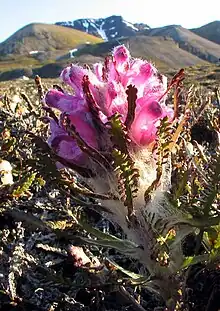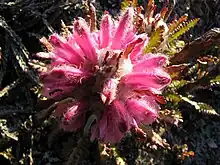| Pedicularis dasyantha | |
|---|---|
 | |
| Scientific classification | |
| Kingdom: | Plantae |
| Clade: | Tracheophytes |
| Clade: | Angiosperms |
| Clade: | Eudicots |
| Clade: | Asterids |
| Order: | Lamiales |
| Family: | Orobanchaceae |
| Genus: | Pedicularis |
| Species: | P. dasyantha |
| Binomial name | |
| Pedicularis dasyantha (Trautv.) Hadac | |
Pedicularis dasyantha, the woolly lousewort or arctic hairy lousewort, is a plant native to the high arctic areas of Svalbard, Novaya Zemlya and the bordering mainland, and the western Taymyr Peninsula. In Svalbard it is restricted to the main island, Spitsbergen.[1]
It grows to 10–15 cm tall, with a stout stem, single or a few together, from a thick, yellow taproot.[1] The basal leaves are numerous and pinnately divided into many remote segments. The stem has many leaves, woolly in the uppermost part between the flowers.[2] The flowers are produced in a dense oblong inflorescence, each flower with a red corolla, with the upper tip hairy; the corolla tube is longer than the calyx.
It grows in moist places and on heaths, often together with Dryas octopetala and Cassiope tetragona. Like all Pedicularis it is a hemiparasite and the preferred host is probably Dryas octopetala.[1]
References

- 1 2 3 "Pedicularis dasyantha". Svalbard Flora. Retrieved 2023-11-25.
- ↑ "Wildflowers - Bering Land Bridge National Preserve". National Park Service. Retrieved 2023-11-25.